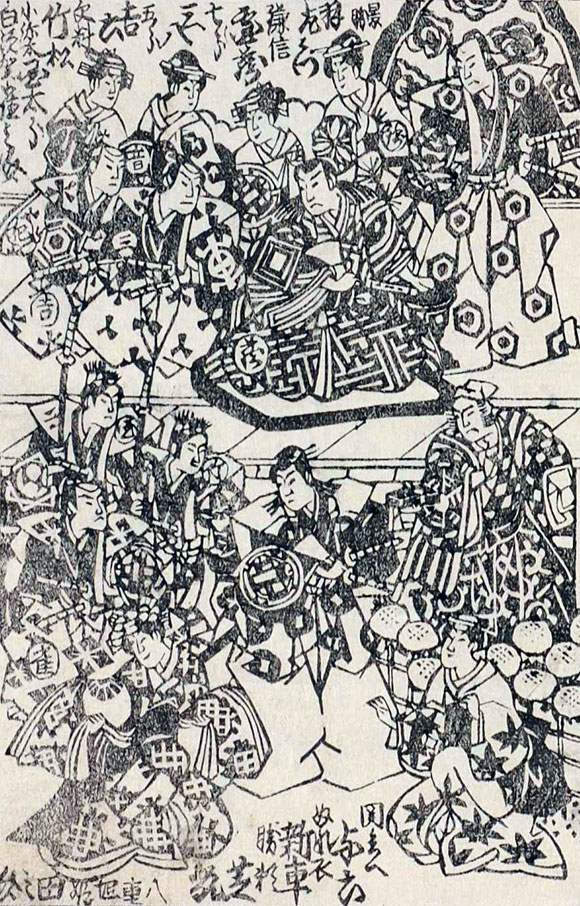| TEPPď WATASHI |
| Play title | Honch˘ Nijűshik˘ |
| Authors | Chikamatsu Hanji Miyoshi Sh˘raku Takeda Inaba Takeda Heishichi Takemoto Saburobŕ II |
| History |
The play "Honch˘ Nijűshik˘" was originally written for the puppet theater (Bunraku) and staged for the first time in the 1st lunar month of 1766 in ďsaka at the Takemotoza. It was adapted for Kabuki a few months later and was produced by both Nakamura Utaemon I and Mimasu Daigor˘ I in ďsaka at the Naka no Shibai [casting]. "Tepp˘ Watashi" ("Delivering the rifle" in English) used to be a standard introduction scene for the staging of the extremely popular "Jusshuk˘" up to the end of the 1950s. It is nowadays rarely staged. |
| Structure |
"Tepp˘ Watashi" ("Delivering the rifle" in English) is the common nickname for the second scene of the 4th act of "Honch˘ Nijűshik˘". The regular title is "Nagao Kenshin Yakata Tepp˘ Watashi" ("the delivery of the rifle at Nagao Kenshin's Mansion"). This short scene is occasionally revived within a t˘shi ky˘gen production of "Honch˘ Nijűshik˘". Kabuki usually skips the part with the arrival of the palanquin of Lady Taoyame to focus only on the rifle delivery scene. It is therefore quite a short scene, no more than 15 minutes long. |
| Key words |
Gidayű Ky˘gen Giri/Ninj˘ J˘shi Kago Nyűd˘ Seppuku Tepp˘ Uesugi Kenshin Uesugi Kagekatsu |
| Summary |
In the compound of his mansion on Lake Suwa, Nagao Kenshin has built a pavilion to receive Lady Taoyame, Sh˘gun Yoshiharu's widow, and Matsuju, his son by his mistress Shizunokata. A gorgeous palanquin supposedly bearing Lady Taoyame and Matsuju arrives but instead of the distinguished guests, a dignified-looking warrior appears from it and, introducing himself as Lady Taoyame's proxy, accuses Kenshin of his failure to fulfill his promise to kill his son Kagekatsu. After making a profound obeisance, Kenshin raises his head to rind to his surprise that the messenger (j˘shi) is none other than Kagekatsu himself. He pretends ignorance, however, and Kagekatsu demands that Kenshin behead his son immediately. Seeing Kenshin hesitate, Kagekatsu attempts to kill himself when the chief gardener Sekibŕ (in reality the nyűd˘ Sait˘ D˘san) appears to stop him. He introduces his newly-employed assistant, Minosaku, to Kenshin. Kenshin immediately recognizes him as Katsuyori but, again pretending ignorance, he proposes to raise his status to samurai. Saying that he will send Minosaku to Shiojiri as his messenger, Kenshin orders Kagekatsu to go there ahead of Minosaku. Kenshin, pretending to consider Sekibŕ as trustworthy, takes him beside a roped palanquin the like of which is ordinarily used to confine a criminal. In this case "the Criminal" proves to be the rifle used for the assassination of Sh˘gun Yoshiharu. Kenshin delivers the weapon to Sekibŕ and orders him to find the assassin, using it as a clue. After Kenshin has retired Sekibŕ says to himself that his new assignment is too difficult for him to perform and that gardening is just the right job for him. Source: Hironaga Shűzabur˘ |
 |
|
"Honch˘ Nijűshik˘" in the 9th lunar month of 1861 at the Ichimuraza, with Nakamura Shikan IV (Minosaku, in reality Takeda Katsuyori), Ichimura Uzaemon XIII (Nagao Kagekatsu), Sawamura Tanosuke III (Princess Yaegaki), Ichikawa Shinsha I (Nureginu), Ichikawa Danz˘ VI (Nagao Kenshin) or Asao Yoroku II (Sekibŕ, in reality the nyűd˘ Sait˘ D˘san) |
|
|
| Contact | Main | Top | Updates | Actors | Plays | Playwrights | Programs | Links | FAQ | Glossary | Chronology | Illustrations | Prints | Characters | Derivatives | Theaters | Coming soon | News |